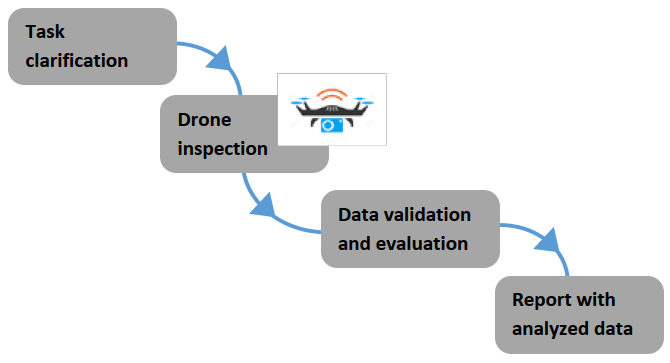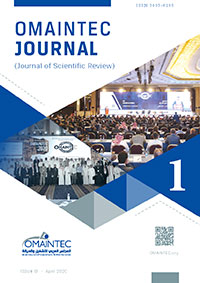Mohammed Abdulaziz, Emad M. El-Said
1Simtran Product Development i.G., Eningen, Germany – 2Fayoum University, Fayoum, Egypt

The unmanned vehicles are used long time ago for many tasks to provide better performance and reduced cost and time. A well-known example is Diedi project, in which an unmanned vehicle was used to discover a confined space inside the Egyptian great pyramid. Since the 3rd industrial revolution the humans started to use the unmanned vehicles to carry out more tasks in behalf of them in order to minimize the cost and increase the quality of the performance.
Abdulaziz et al. [1] performed an experimental work to explain how the usage of unmanned aircrafts for performing the maintenance works in confined spaces reduce the time and cost. They used remotely controlled quadcopters to perform inspections. The paper discussed how the data could be implemented into an industry 4.0 system as well.
Preventive maintenance works of a centrifugal pump station in terms of pump vibration and temperature are running on cost and time. Many papers investigated a number of contactless measurements methods, which could be used for pumps.
One of many papers about contactless vibration measurement methods is that published by Nassif et al. [4]. They compared experimental results of the contactless vibration measurement data of a laser Doppler vibrometer – LDV with contact sensors. The LDV expressed a good performance in comparison to the contact vibration sensors.
The very recent work of Fernando Moreu and Mahmoud Taha from the University of New Mexico in July 2018 “Railroad Bridge Inspections for Maintenance and Replacement Prioritization Using Unmanned Aerial Vehicles (UAVs) with Laser Scanning Capabilities” is indicating a very similar idea to that used in the present paper. The experiments of them were more compacted as those of the present work.
Using the infrared photography for temperature measurement is common and has many applications in the industry and laboratory experiments. In comparison to other temperature measurement techniques, the infrared has a good ability to perform a precise measurement [5].
The present paper introduces and validates the idea of using remote sensing unit carried on an unmanned aircraft to perform the needed measurements as a part of preventive maintenance program of a centrifugal pump station. Loading such devices on the bottom of an AUAV was a challenge [see Figure 1].

Fig.1: Drone equipped with remote sensing unit [3]. P1
The main goal of this presented technique is to have a data, which are remotely sent and implemented into an industry 4.0 system to help the main control unit of the pump station to have a supported decision within short time and at high precision. A flow diagram of the inspection procedure is shown in figure 2.
In the following sections, more details about the experiment will be discussed and the results will be investigated in terms of time and cost.

Fig. 2: A flow diagram of the inspection procedure showing the role of remotely operated vehicles [1].
Experimental Investigation and Results #
An AUAV (programmed quadcopter) was used to fly over a pump station, which has 10 pumps, to perform infrared imaging and vibration remote sensing. Two remote measurement devices were mounted on the bottom side of the drone, which are LDV and IR-camera. The drone was equipped by a wireless communication module to send data to the control system.
Figure 4 shows the layout of the pump station, which is considered as a test field. The station was selected at a water treatment plant in south Germany. It was selected to have exposed mechanical components, which are not covered by pipelines. The exposed components are easy to be captured by the remote sensing devices without big maneuvering effort. The goal of that is to make the inspection flight programming more simple and precise. The ten pumps are identical and has an overall reference vibration RMS value of 13 m/s2 measured by the supplier at the best efficiency point. The ambient temperature inside the pump roam was measured 31°C average. The measurements were done while all pumps were active.

Fig. 3: Thermal imaging as a temperature measurement technique for centrifugal pumps [6].
A personal computer was used to receive measurements data from the drone and perfumes the analysis. The analysis had been done using a software provided by the IR camera supplier and installed on the used PC.

Fig. 4: The pump roam layout and the fly path.
For further validation of the results, a manual measurements had been done using contact sensors. The both results were compared in a further phase of experiment done after analysis. After many trails, a low altitude flight measurements had been considered for validation. The flowing figures show the results and a comparison with the classic measurement method. Furthermore a figure shows the time consumed for both methods is prepared for cost estimation, which will be discussed in the conclusions.

Fig. 5: Vibration results.
Figure 5 shows the measured RMS vibration values as a percent of the reference value. The figure shows a results comparison between the LDV and contact SKF measurement device. The points of the figure are shown to be pointwise per pump. Furthermore, figure 6 shows the comparison for the maximum measured temperature.

Fig. 6: Temperature results.
Conclusions #
The present paper introduce the idea that both vibration and temperature could be measured in efficient way by using contactless measurement devices mounted on an unmanned aircraft. A pump station consist of ten water centrifugal pumps was used a test field. The measured values were validated by a fair comparison with a classic method of measurements.
Both comparisons of vibration and temperature show a good agreement, which indicates that using such measurement method in the preventive maintenance may be efficient if used under the same conditions and application.
Moreover, the time consumed was reduced by 40% if compared by classic measurements method, in which the humans are playing the main role. The way, by which the data sent and analyzed, is an ideal way to be implemented in an Industry 4.0 system. The data are easy to be collected, sent and analyzed.
References #
| [1] | M. Abdulaziz, E. Elsaid, “Automated Maintenance Team for Confined Spaces: Unmanned Aircraft”, OMAINTEC Conference 2017. |
| [2] | Drew Michel, “Remotely Operated Vehicles”, knowledge and skill guidelines for marine science and technology, volume 3. |
| [3] | https://www.polytec.com/eu/optical-systems (access 27.08.2018). |
| [4] | H. Nassif, M. Gindy, J. Davis, “Comparison of laser Doppler vibrometer with contact sensors for monitoring bridge deflection and vibration”, NDT & E International – Volume 38, Issue 3, April 2005, Pages 213-218. |
| [5] | P. Childs, J. Greenwood, C. Long, “Review of temperature measurement”, Review of Scientific Instruments 71, 2959 (2000). |
| [6] | http://a.fluke.com (access 27.08.2018). |
| [7] | http://onlinepubs.trb.org/onlinepubs/IDEA/FinalReports/Safety/Safety32.pdf (access 29.08.2018). |







